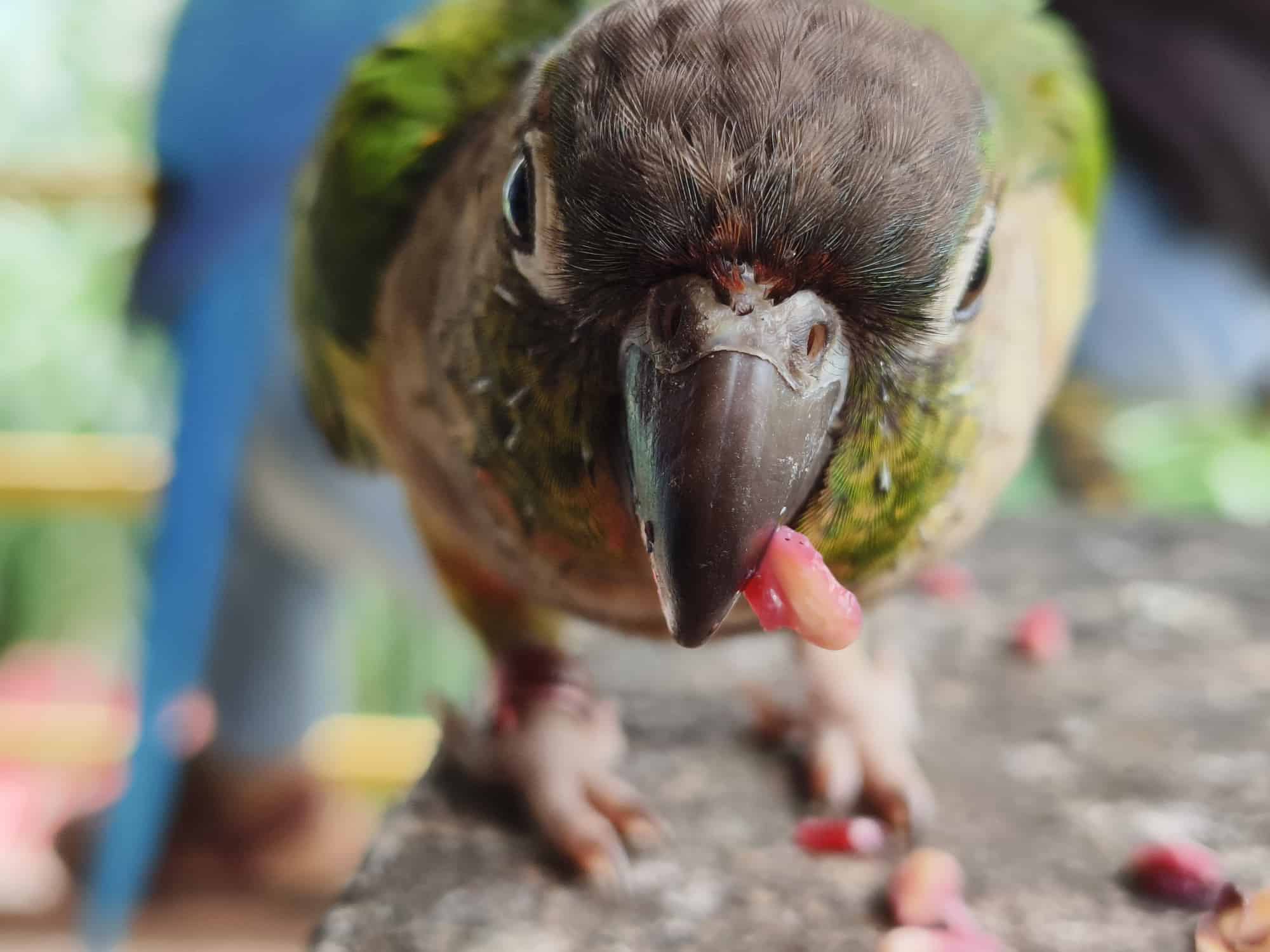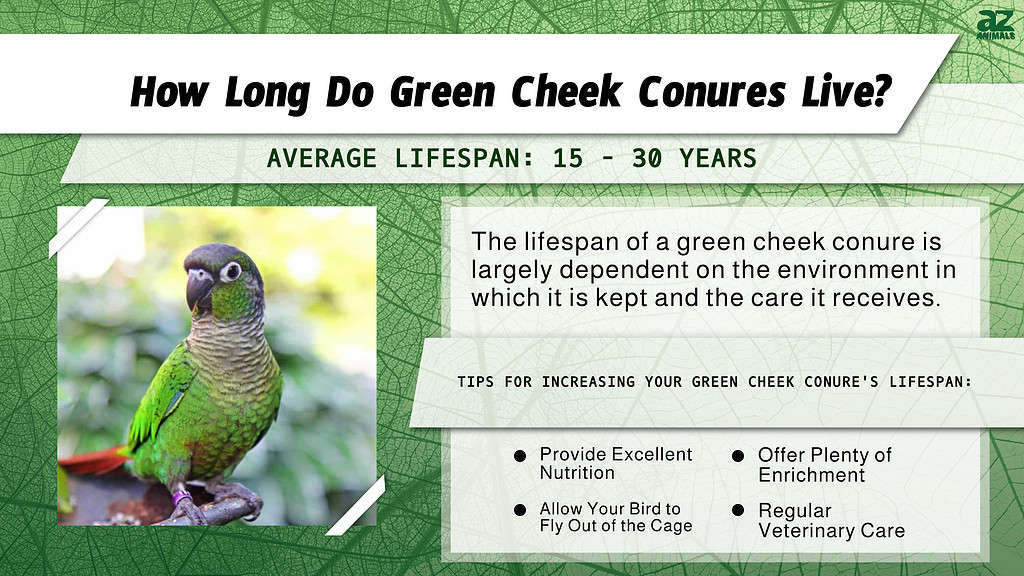
Green cheek conures, beloved for their playful personalities and vibrant plumage, have captivated bird enthusiasts worldwide. In this article, we delve into the fascinating topic of green cheek conure lifespan, providing insights into how long these delightful parakeets can live as cherished companions in our lives.
Keeping Green Cheek Conures as Pet Parakeets

Some green cheek conures will learn how to speak, and others will not.
©Jordan Tan/Shutterstock.com
Green cheek conures make great pet parakeets! They are small, active, and full of personality. These birds have beautiful green and yellow feathers, and they love to explore. They are also known to be quite vocal, so they are sure to liven up any home.
Green cheek conures are intelligent and can be easily trained to do tricks. They also enjoy spending time with their owners and love to be held and cuddled. They can even be trained to speak a few words!
Green cheek conures require a large cage with plenty of toys and a perch for them to climb and explore. They need a variety of foods, including balanced pellets, fresh fruits and vegetables, nuts, and seeds. They also need to have plenty of time out of their cage to stretch their wings and explore.
The Lifespan of Green Cheek Conures
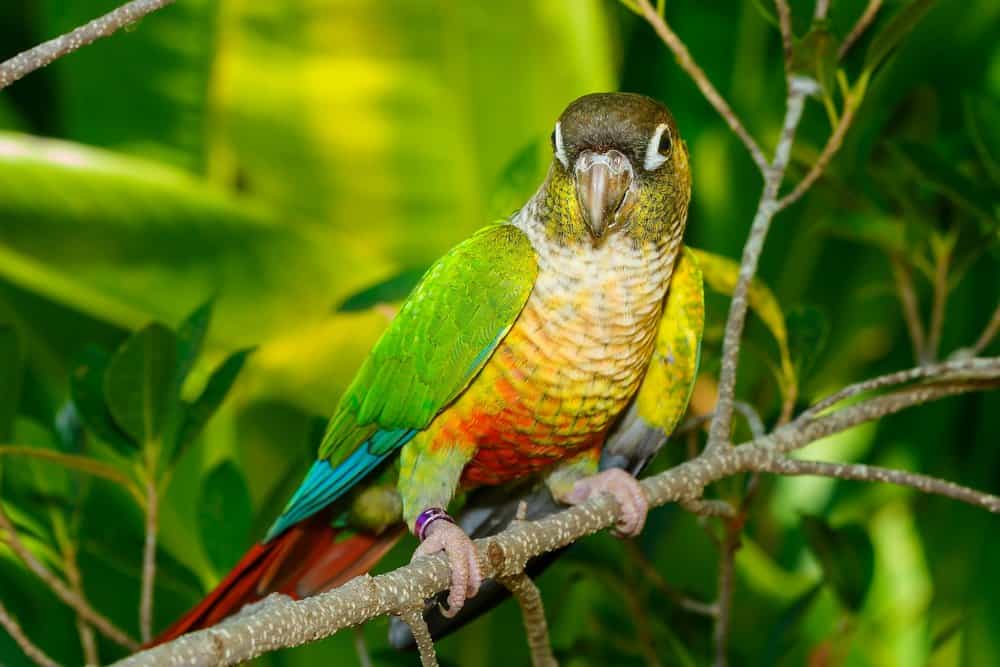
Conures are intelligent and noisy, often mimicking sounds and learning vocabulary.
©boyphare/Shutterstock.com
Green cheek conures are a type of parrot native to Central and South America. They are one of the most popular pet parrots due to their playful and entertaining behavior and their relatively small size. Green cheek conures are relatively long-lived compared to other bird species, with an average lifespan of 15-30 years.
The lifespan of a green cheek conure is largely dependent on the environment in which it is kept and the care it receives. Providing a healthy diet with plenty of fresh fruits and vegetables is essential to ensuring optimal health and longevity. Additionally, providing plenty of mental stimulation and opportunities for physical activity is important to keeping a conure happy and healthy. Birds that are left alone in captivity can live for less than 10 years.
Environmental factors can also play a role in determining a conure’s lifespan. For example, exposure to high levels of pollutants such as smoke or pesticides can have a negative impact on the bird’s health. Additionally, overcrowding can reduce the lifespan of a conure, as can a lack of veterinary care.
Finally, genetics can also play a role in determining the lifespan of a green cheek conure. While there is no way to predict how long any particular bird will live, conures with healthier genes tend to live longer than those with weaker genetics.
In conclusion, if you give your green cheek conure attention and care, its maximum lifespan is 30 years. This can vary depending on environmental and genetic factors. Providing a healthy diet, plenty of mental stimulation and physical activity, and sufficient veterinary care are the best ways to ensure a long and healthy life for your pet conure.
Care and Maintenance: Nutrition, Enrichment, and Veterinary Care
People wishing to keep a green-cheek conure as a pet should either get one bird to form a bond with or two birds to form a bond with each other. However, it is not recommended to house different types of birds together.
Nutrition
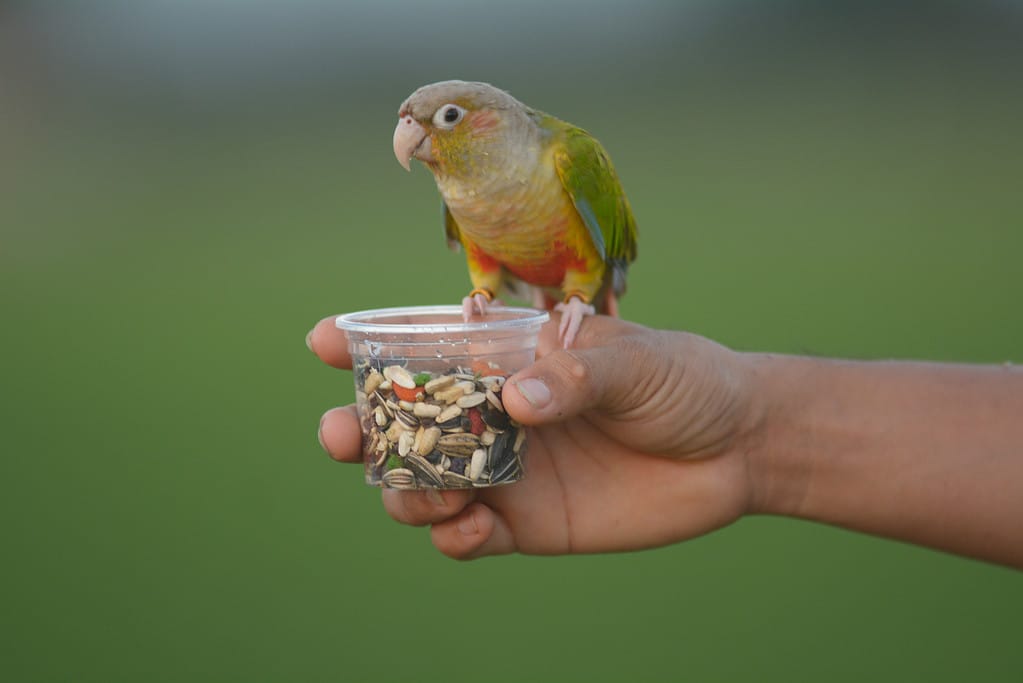
If you keep a green cheek conure as a pet, providing high-quality food is essential to their lifespan.
©aee_werawan/iStock via Getty Images
Green cheek conures require a varied and balanced diet, as with any other pet. They should be provided with a diet that consists of a variety of fruits, vegetables, and seeds. Fruits should be fresh or frozen, and vegetables should be cooked or steamed to ensure optimal nutrition. Feed them a diet that is 70 percent pelleted food that is specifically designed for conures. Green cheek conures also need to be provided with a calcium supplement, such as cuttlebone, to ensure proper bone and beak growth.
- Provide fresh water daily.
- Toxic foods include fruit seeds, caffeine, alcohol, and avocados.
- Unhealthy foods include sugar, salty foods, and processed fatty treats.
- In order for a Green Cheek Conure to lead a long and healthy life, they should be fed a nutritionally complete and balanced pelleted food made specifically for conures, which should make up the majority of their diet.
- Additionally, small amounts (10 percent) of fresh vegetables, fruits, and fortified seeds can be offered as an occasional treat. Remove any fresh food that is uneaten within 3 hours and discard it.
- If you have more than one bird, provide multiple feeding stations.
Enrichment
Green cheek conures are known to be very playful, so it’s important to provide them with plenty of enrichment activities. This can include providing them with toys, perches, and swings to keep them entertained and to help them stay active. It’s also important to provide them with plenty of out-of-cage playtime to help them stay healthy and strengthen the bond between you and your bird.
- To keep a Green Cheek Conure engaged, its habitat should have a variety of toys with vivid colors, different shapes, and unique textures.
- Make sure the toys are firmly attached to the enclosure because these birds can loosen the C-clamps and get injured.
- It is important to avoid toys with small parts that the bird can pull off and swallow. Toys made from paper, cardboard, or hard plastic that cannot be chewed up are preferable.
- Without toys and human interaction, the bird can become bored, pluck its feathers, shriek, or engage in other harmful activities; for this reason, it is important to switch up the toys periodically.
Enclosure
A metal grate should be included in the enclosure of a green cheek conure to allow droppings to drop away from the bird’s feet and make cleaning easier. Additionally, the bottom tray should be lined with habitat paper or another paper-based material to reduce dust.
UV light is essential for these parakeets as it helps them absorb calcium and make Vitamin D. Therefore, a light designed for birds should be placed near their habitat for 10-12 hours a day and changed every six months.
Lastly, a water dish that is large enough for the bird to bathe in should be provided, and if they don’t bathe regularly, they can be misted gently a few times a week with warm water from a plant mister.
- Use the largest habitat that you can fit in your space. The minimum size for this type of bird is 24 inches wide, 24 inches deep, by 30 inches high.
- Be sure that the enclosure has bars that are spaced no farther than three-quarters of an inch apart.
- Wood cages are nearly impossible to properly disinfect. Wire, metal, or plastic is better.
- Provide a perch that is a minimum of nine inches long. The dowels need to be a half inch in diameter for their feet.
- Several perches of different materials are best. Braided ropes, branches, and wooden dowels are good. Sandpaper is not a good choice.
Veterinary Care
Green cheek conures should be kept up to date with their veterinary care, just as any other pet. This includes annual checkups and vaccinations, as well as bloodwork and fecal exams to ensure that your bird is in good health. It’s also important to provide them with regular nail trims to keep them comfortable and healthy.
Overall, green cheek conures make wonderful pets for those who are able to provide them with the proper care and attention. With proper nutrition, enrichment, and veterinary care, they can lead long and happy lives as your companion.
Health Considerations: Common Issues and Preventive Care
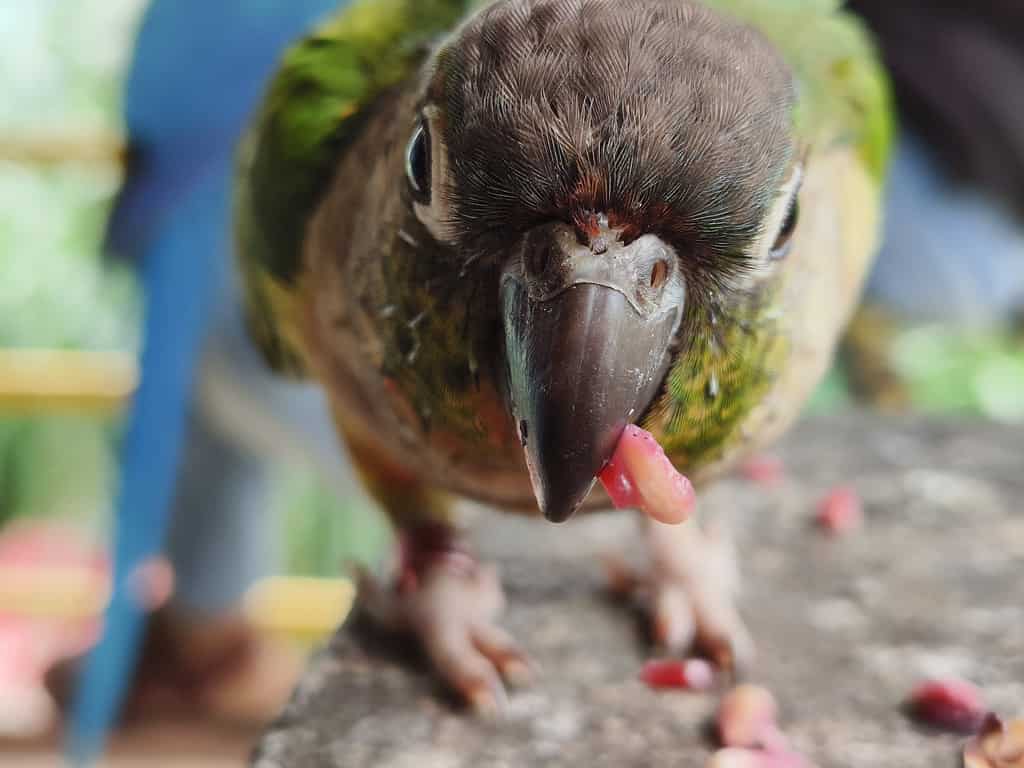
It is safe to give fruit to your green cheek conure, but only in small amounts.
©Jayantibhai Movaliya/iStock via Getty Images
Green cheek conures are delightful, intelligent, and highly interactive pet birds. As with any pet, it is important to understand the common health issues and preventive care that may be necessary to ensure their long-term health and well-being.
The most common health issue for green cheek conures is respiratory infection. This is usually caused by stress, overcrowding, or poor nutrition. The infection can be prevented by ensuring the bird has a stress-free environment, proper nutrition, and plenty of space to move around and exercise.
Parasites are another common health issue for green cheek conures. Parasites can be transmitted from other animals through contact with contaminated food or through contact with contaminated surfaces. Regular deworming and taking precautions with contact with other animals can help to prevent parasites.
Chlamydiosis or parrot fever is also common with this bird. Symptoms include lime green feces, swollen tummy, difficulty breathing, loss of appetite, runny nose or eyes. To prevent this disease, keep the cage clean and disinfect the food and water bowls between each use.
Lastly, the Polyoma Virus is a dangerous illness caused by droppings and feathers. Keeping the bird’s cage and environment clean and removing all fecal matter daily is essential. Symptoms include lethargy, weight loss, bruised skin, and anorexia. Birds can die very suddenly from this virus.
Promoting Longevity: Creating a Healthy Environment

Give your bird a lot of mental enrichment and attention to ensure a long lifespan.
©Tracy Starr/Shutterstock.com
Creating a healthy environment for your green cheek conure is essential to promoting a long lifespan. The key to a long, healthy life for your bird is to provide it with a safe, comfortable environment with plenty of space to move around and explore.
A good diet is also essential for your pet’s health. A balanced diet of all essential vitamins and minerals is important for your bird’s well-being. Make sure to provide fresh, clean water every day. Also, make sure to monitor your bird’s food intake and adjust as needed.
In addition to diet, exercise is also important for your pet’s health. Provide plenty of playtime and activities, such as climbing, foraging, and flying. Avoid activities that may cause stress or injury to your pet.
Finally, it is important to keep your pet’s environment clean and free from toxins. Make sure to clean its cage regularly and use non-toxic cleaning products. Also, keep your pet away from hazardous materials, such as paint, aerosol sprays, and other chemicals that may be harmful. Do not use non-stick appliances or cookware in the same house as a pet bird.
By following these tips, you can help to ensure your green cheek conure lives out its full lifespan of 30 years.
Thank you for reading! Have some feedback for us? Contact the AZ Animals editorial team.

